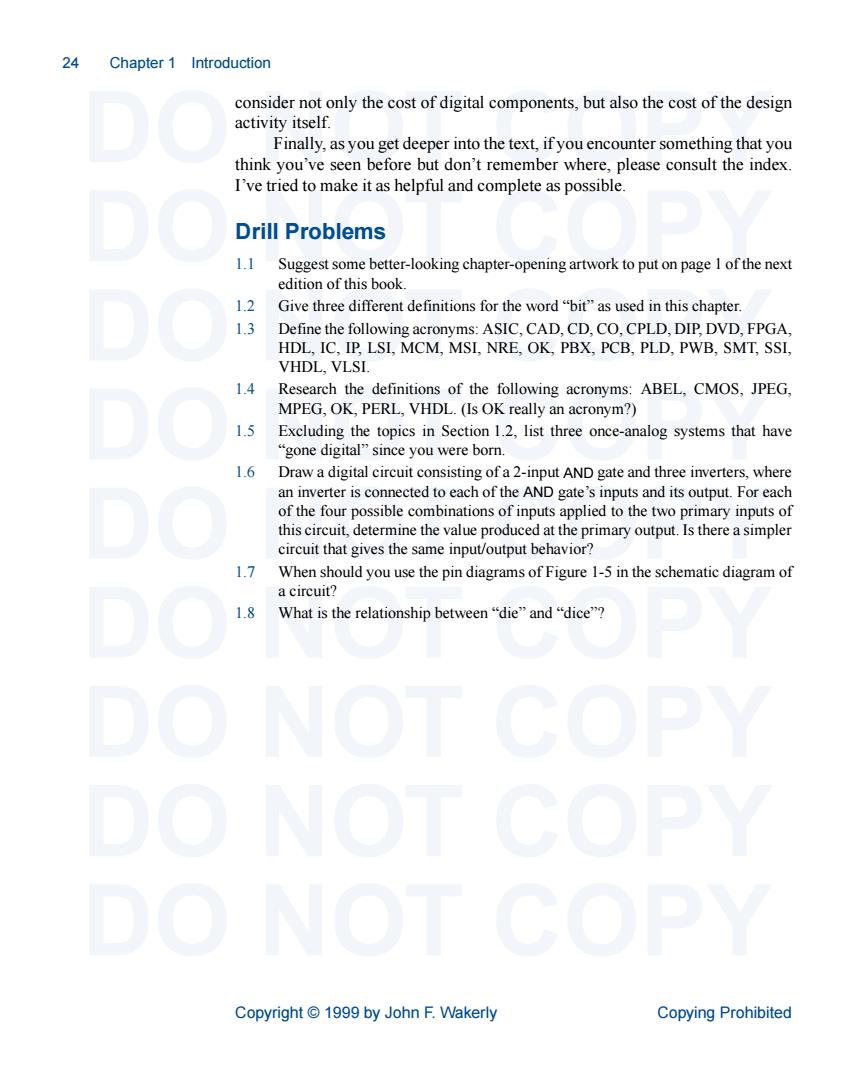正在加载图片...

3 Chapter 1 Introduction consider not only the cost of digital components,but also the cost of the design activity itself. Finally,as you get deeper into the text,if you encounter something that you think you've seen before but don't remember where,please consult the index. I've tried to make it as helpful and complete as possible. Drill Problems 1.1 Suggest some better-looking chapter-opening artwork to put on page 1 of the next edition of this book. 12 Give three different definitions for the word"bit"as used in this chapter. 1.3 Define the following acronyms:ASIC.CAD.CD.CO.CPLD.DIP.DVD.FPGA. HDL,IC,IP,LSI,MCM,MSI,NRE,OK,PBX,PCB,PLD,PWB,SMT,SSI VHDL.VLSI. 1.4 Research the definitions of the following acronyms:ABEL,CMOS,JPEG, MPEG,OK,PERL,VHDL.(Is OK really an acronym?) 1.6 Draw a digital circuit consisting of a 2-input AND gate and three inverters,where an inverter is connected to each of the AND gate's inputs and its output.For each of the four possible combinations of inputs applied to the two primary inputs of thiscircuit,determine the value produced at the primary output.Is there asimpler circuit that gives the same input/output behavior? 1.7 When should you use the pin diagrams of Figure 1-5 in the schematic diagram of a circuit? 1.8 What is the relationship between"die"and"dice"? NOT COPY DO NOT COPY NOT COPY Copyright 1999 by John F.Wakerly Copying Prohibited 24 Chapter 1 Introduction DO NOT COPY DO NOT COPY DO NOT COPY DO NOT COPY DO NOT COPY DO NOT COPY DO NOT COPY DO NOT COPY DO NOT COPY Copyright © 1999 by John F. Wakerly Copying Prohibited consider not only the cost of digital components, but also the cost of the design activity itself. Finally, as you get deeper into the text, if you encounter something that you think you’ve seen before but don’t remember where, please consult the index. I’ve tried to make it as helpful and complete as possible. Drill Problems 1.1 Suggest some better-looking chapter-opening artwork to put on page 1 of the next edition of this book. 1.2 Give three different definitions for the word “bit” as used in this chapter. 1.3 Define the following acronyms: ASIC, CAD, CD, CO, CPLD, DIP, DVD, FPGA, HDL, IC, IP, LSI, MCM, MSI, NRE, OK, PBX, PCB, PLD, PWB, SMT, SSI, VHDL, VLSI. 1.4 Research the definitions of the following acronyms: ABEL, CMOS, JPEG, MPEG, OK, PERL, VHDL. (Is OK really an acronym?) 1.5 Excluding the topics in Section 1.2, list three once-analog systems that have “gone digital” since you were born. 1.6 Draw a digital circuit consisting of a 2-input AND gate and three inverters, where an inverter is connected to each of the AND gate’s inputs and its output. For each of the four possible combinations of inputs applied to the two primary inputs of this circuit, determine the value produced at the primary output. Is there a simpler circuit that gives the same input/output behavior? 1.7 When should you use the pin diagrams of Figure 1-5 in the schematic diagram of a circuit? 1.8 What is the relationship between “die” and “dice”?